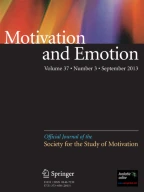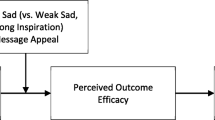Harmful fun: Pranks and sadistic motivation

Two studies tested whether pranking is a context for observing sadistic motivation, understood as a compensatory/restorative response to insults to the self that manifests as displaced aggression. A disrespect sensitivity/anger rumination (DSAR) index outperformed a measure of dispositional sadism in predicting sadistic thoughts and emotions congruent with sadistic motivation across the span of a recalled prank (Study 1). DSAR also predicted greater sadistic affect/motivation and greater self-elevation/victim derogation among prank viewers when the prospect of significant long-term harm befalling prank victims was salient, but not when harm was minimized (Study 2). Fueled by displaced hostility, enjoyment of others’ experienced harm in pranking contexts indeed appears sadistic.
This is a preview of subscription content, log in via an institution to check access.
Access this article
Springer+ Basic
€32.70 /Month
- Get 10 units per month
- Download Article/Chapter or eBook
- 1 Unit = 1 Article or 1 Chapter
- Cancel anytime
Buy Now
Price includes VAT (France)
Instant access to the full article PDF.
Rent this article via DeepDyve
Similar content being viewed by others

Sad but smiling? How the combination of happy victim images and sad message appeals increase prosocial behavior
Article 02 January 2021

Your Pain, My Gain: The Interpersonal Context of Sadism
Chapter © 2016
Motives matter: The emotional consequences of recalled self- and other- focused prosocial acts
Article 16 October 2017
Notes
In preliminary analyses, gender did not alter the pattern of reported results in either study whether considered as a covariate or as a moderator, so it will not be discussed. Study 1 participants completed two other measures that were not of central importance to the present research: (1) Jonason and Webster’s (2010) 12-item “Dirty Dozen” scale, which assesses individual differences in psychopathy, Machiavellianism, and narcissism; and (2) Gross and John’s (2003) 10-item Emotion Regulation Questionnaire (ERQ), which includes subscales measuring individual differences in reliance on two distinct emotion regulation strategies: cognitive reappraisal (changing how one feels by changing one’s thinking) and expressive suppression (restricting overt displays of emotion). Consistent with previous research (e.g., Buckels et al. 2013), dispositional sadism was moderately positively correlated with all three Dark Triad components (rs = 0.35–0.44). Correlations between DSAR and the Dark Triad were somewhat higher (rs = 0.51–0.56). Expressive suppression was significantly positively correlated with both DSAR, r (130) = 0.25, p = .004, and dispositional sadism, r (130) = 0.17, p = .047. In contrast, cognitive reappraisal was negatively correlated with DSAR (due wholly to the anger rumination component), r (130) = − 0.19, p = .032, and not significantly correlated with dispositional sadism, r (130) = − 0.07, p = .409. Thus, both DSAR and dispositional sadism were linked to an emotion regulation style that is arguably congruent with voluntary inhibition of overt negative reactions to an experience of insult. Speculatively, because ES tends to be rather ineffective at reducing the underlying arousal associated with such aversive experiences (see Gross 2014), this may contribute to the amplification of (displaced) sadistic motivation.
References
- Balakrishnan, A., Plouffe, R. A., & Saklofske, D. H. (2017). What do sadists value? Is honesty-humility an intermediary? Replicating and extending findings on the link between values and “dark” personalities. Personality and Individual Differences, 109, 142–147. doi:10.1016/j.paid.2016.12.055. ArticleGoogle Scholar
- Baumeister, R. F. (1997). Evil: Inside human cruelty and violence. New York: W. H. Freeman. Google Scholar
- Brambilla, M., & Riva, P. (2017). Predicting pleasure at others’ misfortune: Morality trumps sociability and competence in driving deservingness and schadenfreude. Motivation and Emotion, 41, 243–253. doi:10.1007/s11031-016-9594-2. ArticleGoogle Scholar
- Brankhurst-Cuff, C. (2017, January 12). YouTube “social experiments” are the worst kind of smug white racism. Retrieved from https://www.vice.com/en_ca/article/d77gzq/youtube-social-experiments-are-the-worst-kind-of-smug-white-racism.
- Buckels, E. E., Jones, D. N., & Paulhus, D. L. (2013). Behavioral confirmation of everyday sadism. Psychological Science, 24, 2201–2209. doi:10.1177/0956797613490749. ArticlePubMedGoogle Scholar
- Buckels, E. E., Trapnell, P. D., & Paulhus, D. L. (2014). Trolls just want to have fun. Personality and Individual Differences, 67, 97–102. doi:10.1177/0956797613490749. ArticleGoogle Scholar
- Burris, C. T., & Leitch, R. (2016). Your pain, my gain: The interpersonal context of sadism. In K. Aumer (Ed.), The psychology of love and hate in intimate relationships (pp. 85–103). Cham: Springer International. Google Scholar
- Burris, C. T., & Mathes, S. (2011). Digging in my secret garden: Disinhibitory effects of the “Hidden Observer” on reported sexual fantasies. Canadian Journal of Human Sexuality, 20, 143–150. Google Scholar
- Chester, D. S., & DeWall, C. N. (2017). Combating the sting of rejection with the pleasure of revenge: A new look at how emotion shapes aggression. Journal of Personality and Social Psychology, 112, 413–430. doi:10.1037/pspi0000080. ArticlePubMedGoogle Scholar
- Craker, N., & March, E. (2016). The dark side of Facebook®: The Dark Tetrad, negative social potency, and trolling behaviours. Personality and Individual Differences, 102, 79–84. doi:10.1016/j.paid.2016.06.043. ArticleGoogle Scholar
- Dundes, A. (1988). April Fool and April Fish: Towards a theory of ritual pranks. Etnofoor, 1, 4–14. Google Scholar
- Greitemeyer, T. (2015). Everyday sadism predicts violent video game preferences. Personality and Individual Differences, 75, 19–23. doi:10.1016/j.paid.2014.10.049. ArticleGoogle Scholar
- Greitemeyer, T., & Sagioglou, C. (2016). Subjective socioeconomic status causes aggression: A test of the theory of social deprivation. Journal of Personality and Social Psychology, 111, 178–194. doi:10.1037/pspi0000058. ArticlePubMedGoogle Scholar
- Greitemeyer, T., & Sagioglou, C. (2017). The longitudinal relationship between everyday sadism and the amount of violent video game play. Personality and Individual Differences, 104, 238–242. doi:10.1016/j.paid.2016.08.021. ArticleGoogle Scholar
- Gross, J. J. (2014). Emotion regulation: Conceptual and empirical foundations. In J. J. Gross (Ed.), Handbook of emotion regulation (2nd edn., pp. 3–20). New York: Guilford. Google Scholar
- Gross, J. J., & John, O. P. (2003). Individual differences in two emotion regulation processes: Implications for affect, relationships, and well-being. Journal of Personality and Social Psychology, 85, 348–362. doi:10.1037/0022-3514.85.2.348. ArticlePubMedGoogle Scholar
- Gunn, L., & Caissie, L. T. (2006). Serial murder as an act of deviant leisure. Leisure, 30, 27–53. doi:10.1080/14927713.2006.9651340. ArticleGoogle Scholar
- Hobbs, R., & Grafe, S. (2015). YouTube pranking across cultures. First Monday, 20(7), 1–15 ArticleGoogle Scholar
- Jonason, P. K., & Webster, G. D. (2010). The Dirty Dozen: A concise measure of the Dark Triad. Psychological Assessment, 22, 420–432. doi:10.1037/a0019265. ArticlePubMedGoogle Scholar
- Krizan, Z., & Zohar, O. (2015). Narcissistic rage revisited. Journal of Personality and Social Psychology, 108, 784–801. doi:10.1037/pspp0000013. ArticlePubMedGoogle Scholar
- Marsh, M. (2015). Practically joking. Logan, UT: Utah State University Press. BookGoogle Scholar
- McDonald, K. L. (2008). Interpretations and beliefs associated with children’s revenge goals in conflict situations. Unpublished doctoral dissertation. Duke University.
- Međedović, J. (2017). Aberrations in emotional processing of violence-dependent stimuli are the core features of sadism. Motivation and Emotion, 41, 273–283. doi:10.1007/s11031-016-9596-0. ArticleGoogle Scholar
- O’Meara, A., Davies, J., & Hammond, S. (2011). The psychometric properties and utility of the Short Sadistic Impulse Scale (SSIS). Psychological Assessment, 23, 523–531. doi:10.1037/a0022400. ArticlePubMedGoogle Scholar
- O’Meara, A., & Hammond, S. (2016). The sadistic impulse and relating to others. In J. Birtchnell, M. Newberry, & Kalaitzaki, A. (Eds.), Relating theory—clinical and forensic applications (pp. 277–291). doi:10.1057/978-1-137-50459-3_21.
- Paulhus, D. L. (2014). Toward a taxonomy of dark personalities. Current Directions in Psychological Science, 23, 421–426. ArticleGoogle Scholar
- Pfattheicher, S., & Schindler, S. (2015). Understanding the dark side of costly punishment: The impact of individual differences in everyday sadism and existential threat. European Journal of Personality, 29, 498–505. doi:10.1002/per.2003. ArticleGoogle Scholar
- Plester, B. (2013). When is a joke not a joke? The dark side of organizational humour. Paper presented at the 27th Australia and New Zealand Academy of Management Conference, Hobart, Australia.
- Plouffe, R. A., Saklofske, D. H., & Smith, M. M. (2017). The assessment of sadistic personality: Preliminary psychometric evidence for a new measure. Personality and Individual Differences, 104, 166–171. doi:10.1016/j.paid.2016.07.043. ArticleGoogle Scholar
- Reidy, D. E., Foster, J. D., & Zeichner, A. (2010). Narcissism and unprovoked aggression. Aggressive Behavior, 36, 414–422. doi:10.1002/ab.20356. ArticlePubMedGoogle Scholar
- Russell, T. D., & King, A. R. (2016). Anxious, hostile, and sadistic: Maternal attachment and everyday sadism predict hostile masculine beliefs and male sexual violence. Personality and Individual Differences, 99, 340–345. doi:10.1016/j.paid.2016.05.029. ArticleGoogle Scholar
- Schumpe, B. M., & Lafrenière, M.-A. K. (2016). Malicious joy: Sadism moderates the relationship between schadenfreude and the severity of others’ misfortune. Personality and Individual Differences, 94, 32–37. doi:10.1016/j.paid.2016.01.005. ArticleGoogle Scholar
- Skrapec, C. (2001). Phenomenology and serial murder: Asking different questions. Homicide Studies, 5(1), 46–63. doi:10.1177/1088767901005001004. ArticleGoogle Scholar
- Stanek, B. (2014). The big problem with all those viral ‘social experiment’ videos. Retrieved from https://mic.com/articles/104986/the-big-problem-with-all-of-those-viral-social-experiment-videos#.O1Uzejez8.
- Sukhodolsky, D. G., Golub, A., & Cromwell, E. N. (2001). Development and validation of the Anger Rumination Scale. Personality and Individual Differences, 31, 689–700. ArticleGoogle Scholar
- Tallman, R. S. (1974). A generic approach to the practical joke. Southern Folklore Quarterly, 38, 259–274. Google Scholar
- Trémolière, B., & Djeriouat, H. (2016). The sadistic trait predicts minimization of intention and causal responsibility in moral judgment. Cognition, 146, 158–171. doi:10.1016/j.cognition.2015.09.014. ArticlePubMedGoogle Scholar
- van Dijk, W. W., Ouwerkerk, J. W., Wesseling, Y. M., & van Koningsbruggen, G. M. (2011). Towards understanding pleasure at the misfortunes of others: The impact of self-evaluation threat on schadenfreude. Cognition and Emotion, 25, 360–368. doi:10.1080/02699931.2010.487365. ArticlePubMedGoogle Scholar
- van Geel, M., Goemans, A., Toprak, T., & Vedder, P. (2017). Which personality traits are related to traditional bullying and cyberbullying? A study with the Big Five, Dark Triad and sadism. Personality and Individual Differences, 106, 231–235. doi:10.1016/j.paid.2016.10.063. ArticleGoogle Scholar
- VidStatsX. (2017). PrankvsPrank YouTube stats. Retrieved from https://vidstatsx.com/PrankvsPrank/youtube-channel.
- Weiss, G. (2016). The good, the bad, and the fake: The rise of YouTube’s prank video genre. Retrieved from http://www.tubefilter.com/2016/04/13/good-bad-fake-the-rise-of-youtube-prank-videos/.
- Wiggins, B. A. (2014). The culture industry, new media, and the shift from creation to curation; or, enlightenment as a kick in the nuts. Television & New Media, 15, 395–412. doi:10.1177/1527476412474696. ArticleGoogle Scholar


